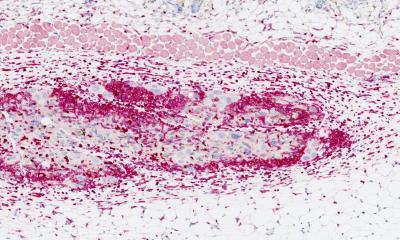
Image source: Hubrecht Institute
News • Inclusion of all cell lineages
Advanced pancreas organoid for better insights
Researchers from the organoid group of the Hubrecht Institute have developed a new organoid that mimics the human fetal pancreas, offering a clearer view of its early development.
The researchers were able to recreate a complete structure that includes the three key cell types in the pancreas, which previous organoids couldn’t fully mimic. Notably, the team identified a new stem cell that develops into the three cell types. These findings, published in Cell, could help researchers better understand the pancreas and develop new treatments for pancreatic diseases in the future.
The pancreas has two main jobs: to help digest food and to manage blood sugar levels. For each of these tasks, the organ uses different types of cells. Scientist can study how the pancreas works by looking at organoids — tiny organs, about 1 mm in size that are grown in the lab. However, most organoids up until now could only exist of one type of cell at a time. This makes it harder for scientists to understand the pancreas as a whole. “We wanted to create an organoid that includes all the cell types found in a real pancreas”, explains Amanda Andersson Rolf, first author of the study. “With such an organoid, we could study how these different cells interact and gain a deeper understanding of how the pancreas develops.”
We saw that the three cell types not only formed but also performed their expected functions. The acinar cells released digestive enzymes and the endocrine cells produced hormones
Amanda Andersson Rolf
Andersson Rolf and her fellow researchers used tissue from the pancreas to create a new three-dimensional organoid that imitates the human pancreas in its fetal stage. This organoid contained the three main types of pancreas cells: acinar cells, ductal cells, and endocrine cells as shown in the video below. Each of these cells plays a vital role. Acinar cells release enzymes that help break down food, while ductal cells form channels to carry the enzymes to the gut. Finally, endocrine cells produce hormones like insulin to control sugar levels in the blood. “In our organoid, we discovered and characterized a new type of stem cell that has the unique ability to develop into all three cell types”, Andersson Rolf continues. “We saw that the three cell types not only formed but also performed their expected functions. The acinar cells released digestive enzymes and the endocrine cells produced hormones.”
Using these organoids, the researchers discovered new information about how the pancreas develops. “The stem cell of the fetal pancreas is present longer than scientists have seen in earlier studies with mice”, Andersson Rolf says. Interestingly, the organoids grown from one of these stem cells can grow rapidly over several years while still being able to produce the three main cell types of the pancreas. Andersson Rolf and her colleagues found another crucial difference between mouse and human pancreatic development. “We saw the presence of a protein called LGR5, which marks stem cells across different tissues. This protein appears in human pancreatic stem cells but not in mice”, Andersson Rolf explains. “Our research highlights the importance of studying human biology, as we couldn’t have discovered this using animal cells”, she notes.
The new organoid that mimics the fetal pancreas can give scientists new ways to study how genes and the environment affect the development and health of the pancreas. Ultimately, studying these organoids could help develop regenerative therapies and new drugs to treat pancreatic diseases. “However, we first need to fully understand how the cells and molecules in the human pancreas work together during development and in disease”, Andersson Rolf explains. “We are just starting to scratch the surface.”
Source: Hubrecht Institute
04.12.2024











